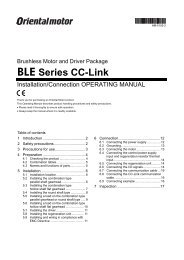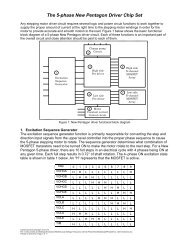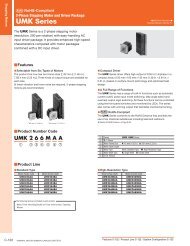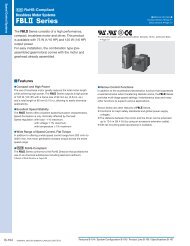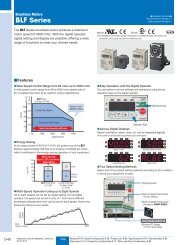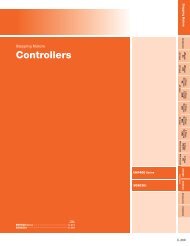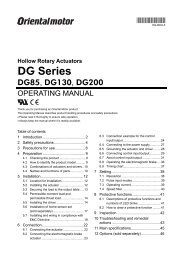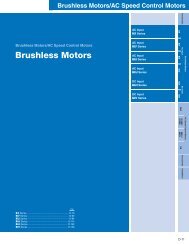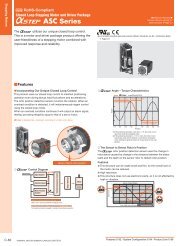Torque Motors - Oriental Motor
Torque Motors - Oriental Motor
Torque Motors - Oriental Motor
You also want an ePaper? Increase the reach of your titles
YUMPU automatically turns print PDFs into web optimized ePapers that Google loves.
<strong>Torque</strong> <strong><strong>Motor</strong>s</strong><br />
●Additional Information●<br />
Technical reference ➜ Page G-1<br />
Safety standards ➜ Page H-2<br />
<strong>Torque</strong> motors are designed to provide high starting<br />
torque and sloping characteristics (torque is highest<br />
at zero speed and decreases steadily with increasing<br />
speed), and operate over a wide speed range. They<br />
also provide stable operation, especially in the low<br />
speed range or under a locked rotor condition.<br />
●For detailed product safety standard information including standards, file number and<br />
certification body, please visit www.orientalmotor.com.<br />
(Gearhead sold separately)<br />
■Features<br />
●The Speed Can Vary Widely, Depending on the Sloping<br />
Characteristics<br />
<strong>Torque</strong> motors have a high<br />
starting torque and sloping<br />
characteristics, allowing<br />
easy speed control simply<br />
by changing the voltage<br />
supplied to the motor.<br />
(The motor torque varies in<br />
proportion to the square of<br />
the voltage.)<br />
V 1<br />
V 2<br />
V 3<br />
V 4<br />
V 1 >V 2 >V 3 >V 4<br />
Load<br />
◇Voltage Control of <strong>Torque</strong> <strong><strong>Motor</strong>s</strong><br />
The method most commonly used to control voltage is by phase<br />
control using a triac. As shown in Fig. 1, by changing the phase<br />
angle “alpha” at which the triac switches, the input voltage is<br />
controlled as represented by the shaded areas of the graph.<br />
●When adjusting the speed or the torque, an external voltage adjuster is necessary.<br />
Voltage<br />
Phase<br />
Angle<br />
<strong>Torque</strong><br />
Conductance<br />
Angle<br />
N 4 N 3 N 2 N 1<br />
Speed<br />
●Suitable for Winding Applications<br />
In an application where an object<br />
is released continuously at a Constant Tension Wind Up<br />
constant speed and wound up<br />
with constant tension, the torque<br />
must be doubled and the speed<br />
must be halved if the diameter of<br />
the winding spool is doubled.<br />
●Locked Rotor Operation is Available<br />
Unlike induction motors or reversible motors, torque motors are<br />
designed to provide a stable torque even under locked rotor<br />
conditions or at very low speed (nearly locked rotor condition).<br />
They are suitable for pushing applications that require static torque,<br />
or for loads that are under locked rotor conditions at the end of<br />
processes.<br />
<strong><strong>Motor</strong>s</strong> of 115 VAC input can operate continuously at 60 VAC. When<br />
used at voltages above 60 VAC, these motors have shorter time<br />
ratings. They have a 5 minutes rating at 115 VAC.<br />
Note<br />
●When using a motor in a locked rotor operation,<br />
the output torque becomes very large. The output<br />
torque of the gearhead must be lower than the<br />
maximum permissible torque. Also, ensure that<br />
the load does not hit an object and stop, since<br />
this can cause damage to the gearhead due to the<br />
shock.<br />
Load<br />
α+ϖ<br />
3<br />
2 ϖ<br />
0 α ϖ<br />
2<br />
ϖ 2ϖ<br />
Fig. 1 Phase Control<br />
●Use as a Brake<br />
By using the motor<br />
in the braking region<br />
of the speed – torque<br />
characteristics, it<br />
can serve as a brake.<br />
Constant tension control<br />
can be achieved by<br />
applying a DC voltage.<br />
Brake<br />
C-214<br />
ORIENTAL MOTOR GENERAL CATALOG<br />
2012/2013<br />
Page<br />
Features C-214 / System Configuration C-217 / Specifications C-219 / Product Line C-218<br />
Characteristics C-221 / Dimensions C-222 / Connection Diagrams C-225



